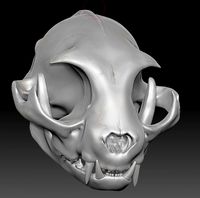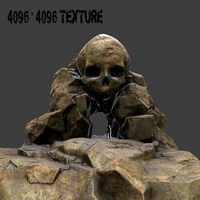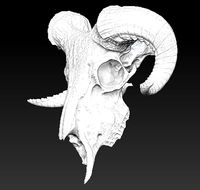Cults

Sphenodon punctatus, Tuatara skull
by Cults
Last crawled date: 6 years, 1 month ago
This file is a 3D surface model that has been created using the original scan data for this specimen. It can be downloaded and printed out using a 3D printer/rapid prototyper or it can be rendered in a 3D application. These files are typically very large, so we do not recommend trying to download them without a high-speed internet connection.
This specimen, a preserved adult head (YPM 9194), was collected by John Ostrom from an unknown locality between 1960 and 1969. It was made available to the University of Texas High-resolution X-ray CT Facility for scanning by Dr. Jacques Gauthier of Yale University. The specimen was scanned for Dr. Chris Bell of The University of Texas at Austin. Funding for image processing was provided by a National Science Foundation Assembling the Tree of Life grant (EF-0334961), The Deep Scaly Project: Resolving Squamate Phylogeny using Genomic and Morphological Approaches, to Drs. Jacques Gauthier of Yale University, Maureen Kearney of the Field Museum, Mike Lee of the University of Adelaide, Jessie Maisano of The University of Texas at Austin, Tod Reeder of San Diego State University, Olivier Rieppel of the Field Museum, Jack Sites of Brigham Young University, and John Wiens of SUNY Stonybrook.
Sphenodon species, also known as tuataras, are the sole living representatives of Rhynchocephalia, the sister taxon to Squamata (the clade that includes lizards, snakes, and amphisbaenians; e.g., Ctenosaura pectinata, Gerrhosaurus major, Rhineura sp., and Varanus gouldii). By necessity, Sphenodon is usually used to represent the first outgroup to Squamata in phylogenetic analyses. However, there is a large gap in the fossil record of rhynchocephalians, from the early Cretaceous up to a subfossil, S. diversum. Extant Sphenodon is highly derived, and this limits its utility for polarizing characters in the evolution of squamates.
This specimen, a preserved adult head (YPM 9194), was collected by John Ostrom from an unknown locality between 1960 and 1969. It was made available to the University of Texas High-resolution X-ray CT Facility for scanning by Dr. Jacques Gauthier of Yale University. The specimen was scanned for Dr. Chris Bell of The University of Texas at Austin. Funding for image processing was provided by a National Science Foundation Assembling the Tree of Life grant (EF-0334961), The Deep Scaly Project: Resolving Squamate Phylogeny using Genomic and Morphological Approaches, to Drs. Jacques Gauthier of Yale University, Maureen Kearney of the Field Museum, Mike Lee of the University of Adelaide, Jessie Maisano of The University of Texas at Austin, Tod Reeder of San Diego State University, Olivier Rieppel of the Field Museum, Jack Sites of Brigham Young University, and John Wiens of SUNY Stonybrook.
Sphenodon species, also known as tuataras, are the sole living representatives of Rhynchocephalia, the sister taxon to Squamata (the clade that includes lizards, snakes, and amphisbaenians; e.g., Ctenosaura pectinata, Gerrhosaurus major, Rhineura sp., and Varanus gouldii). By necessity, Sphenodon is usually used to represent the first outgroup to Squamata in phylogenetic analyses. However, there is a large gap in the fossil record of rhynchocephalians, from the early Cretaceous up to a subfossil, S. diversum. Extant Sphenodon is highly derived, and this limits its utility for polarizing characters in the evolution of squamates.
Similar models
cults
free

Chamaeleo calyptratus, Veiled Chameleon
...ded by a national science foundation digital libraries initiative grant to dr. timothy rowe of the university of texas at austin.
cults
free

Tomistoma schlegelii, False Gharial
...ded by a national science foundation digital libraries initiative grant to dr. timothy rowe of the university of texas at austin.
cults
free

Crocodylus rhombifer, Cuban Crocodile skull
...he natural history of the bahamas without compromising the integrity of the singularly unique and beautifully preserved fossils.
cults
free

Parahyaena brunnea, Brown Hyena skull
...and by a national science foundation digital libraries initiative grant to dr. timothy rowe of the university of texas at austin.
cults
free

Hyaena hyaena, Striped Hyena skull
...nd by a national science foundation digital libraries initiative grant to dr. timothy rowe of the university of texas at austin.
cults
free

Ursus maritimus, Polar Bear skull
...tin. the polar bear is one of several carnivorans included in ongoing research of respiratory turbinates by dr. van valkenburgh.
thingiverse
free

Fossil Horse Foot (Miohippus, Left Fore) by geofablab
...;1588 yale c. 11293".
scan specifications: scanned with the makerbot digitizer desktop 3d scanner set on "dark".
thingiverse
free

Fossil Horse Foot (Miohippus, left hind) by geofablab
...;1588 yale c. 11293".
scan specifications: scanned with the makerbot digitizer desktop 3d scanner set on "dark".
cults
free

Obdurodon dicksoniFossil, Fossil Platypus skull
...cility for scanning by dr. michael archer of the university of new south wales. funding for scanning was provided by dr. archer.
thingiverse
free

Brachiopod (Pentamerida) by geofablab
...rom an unmarked specimen.
scan specifications: scanned with the makerbot digitizer desktop 3d scanner set on "light".
Punctatus
free3d
$55

Ictalurus punctatus Channel Catfish
...ictalurus punctatus channel catfish
free3d
ictalurus punctatus channel catfish
free3d
$49

black bullhead catfish
...realistic 3d model of a black bullhead catfish (ictalurus punctatus. the channel catfish 3d model is a well researched...
3dwarehouse
free

Tuatara (Sphenodon punctatus)
...65 million years! his status: vulnerable. requested by birdman #dinosaur #living_fossil #sphenodon_punctatus #tuatara #vulnerable
Tuatara
humster3d
$75

3D model of SSC Tuatara 2011
... a detailed 3d model of ssc tuatara 2011 in various file formats. all our 3d models were created maximally close to the original.
3d_export
$99

SSC Tuatara 2013 3D Model
...e aero shelby super car sport dream coupe fastest auto 2011 2012 2013 2014
ssc tuatara 2013 3d model swan3dstudios 52646 3dexport
3d_export
$45

SSC Tuatara 2019
...wer output would be rated at 1,350 hp (1,000 kw) or 1,750 hp (1,300 kw) on e85 fuel, along with a 300 mph (483 km/h) + top speed.
thingiverse
free

Star Trek - Gorn Tuatara Class by Burning_Bridges
...n tuatara class by burning_bridges
thingiverse
gorn tuatara class ship from star trek online.
*updated .stl file added 28 oct 18
thingiverse
free

Amazon fire tablet wall mount by Samuellhouston
...wall mount hook for amazon fire 10.1 tablet with tuatara case. uses kickstand loop of tablet case to hang....
3dcadbrowser
free

SSC Tuatara Interior (2012) 3D CAD Model
...3d object can be downloaded in .step, .iges, .max, .obj, .3ds, .fbx, .dxf, .lwo, .stl, .wrl, .ma, .dae, .x and .asc file formats.
thingiverse
free

Giant snail shell by HollowaySmith
...about the same time as the native frogs and tuatara once widespread, many species are now endangered or threatened....
grabcad
free

Tuatara interior
...tuatara interior
grabcad
there are my thoughts and vision for your evaluation.
cg_trader
$26

ssc tuatara super car 3D Model
... 3d model
cg trader
ssc tuatara super car 3d model car wheel speed racing super, formats max, fbx, ready for 3d animation and ot
Skull
3d_export
$40

Cat Skull ZBrush Sculpture 3D Model
...ure 3d model
3dexport
cat feline skull bones kitty cranium pet
cat skull zbrush sculpture 3d model saschasnowstorm 73801 3dexport
3d_ocean
$5

ELEGANT SCULL 3D MODEL
...human jaw lines male medical pirate scientific skeletal skeleton skull teeth zombie elegant scull 3d model .obj and .3ds...
3d_ocean
$29

Cartoon Skeleton Rigged
...cartoon chararcter funny halloween horror mentalray monster rigged skeleton skull toon low poly of a cartoon skeleton made with...
3d_ocean
$9

Skull_Cave_2
...lygon. ..13464 vertices. 4096 * 4096 texture. 5 uw map texture. ao,spec,nor,gl,diff. texture map. obj,fbx,and blend format model.
3d_export
$30

Patterned skull 3D Model
...odel
3dexport
patterned skull
patterned skull 3d model download .c4d .max .obj .fbx .ma .lwo .3ds .3dm .stl kex74 104360 3dexport
3d_export
$25

Ram skull 3D Model
...bone head 3dprinter printable
ram skull 3d model download .c4d .max .obj .fbx .ma .lwo .3ds .3dm .stl luckyhunter 113590 3dexport
3d_export
$20

Human Head Skull with Ancient Tribal Tattoo 3D Model
...man head skull with ancient tribal tattoo 3d model download .c4d .max .obj .fbx .ma .lwo .3ds .3dm .stl sanchiesp 105978 3dexport
cg_studio
$45

Human skeleton3d model
...cgstudio human skeletal system human skeleton bones bone spine skull femur teeth skeleton system .obj .mb .max .ma .fbx...
cg_studio
$49

Robot 183d model
...model cgstudio characters robot transformer droid scifi sci fi skull humanoid bot robotic textures materials .max .obj - robot...
3ddd
$1

CB2 Metalhead skull set
...ор ваз и декора от cb2
tessa vase
studded bud vase
metalhead skull
3-piece hat trick vase set
gatz vase
halo taper candle holders
